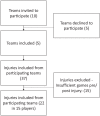Match High-Speed Running Distances Are Often Suppressed After Return From Hamstring Strain Injury in Professional Footballers
- PMID: 33151808
- PMCID: PMC8079800
- DOI: 10.1177/1941738120964456
Match High-Speed Running Distances Are Often Suppressed After Return From Hamstring Strain Injury in Professional Footballers
Abstract
Background: High-speed running is commonly implicated in the genesis of hamstring injury. The success of hamstring injury management is typically quantified by the duration of time loss or reinjury rate. These metrics do not consider any loss in performance after returning to play from hamstring injury. It is not known to what extent high-speed running is altered on return to play after such injury.
Hypothesis: Match high-speed running distance will change after returning from hamstring injury.
Study design: Non-randomized cohort.
Level of evidence: Level 3.
Methods: Match high-speed running distance in highest level professional football (soccer, Rugby League, Rugby Union, and Australian Rules) were examined for a minimum of 5 games prior and subsequent to hamstring strain injury for individual differences using a linear regression models approach. A total of 22 injuries in 15 players were available for analysis.
Results: Preinjury cumulative high-speed running distances were strongly correlated for each individual (r2 = 0.92-1.0; P < 0.0001). Pre- and postinjury high-speed running data were available for a median of 15 matches (range, 6-15). Variance from the preinjury high-speed running distance was significantly less (P = 0.0005) than the post injury values suggesting a suppression of high-speed running distance after returning from injury. On return to play, 7 of the 15 players showed a sustained absolute reduction in preinjury high-speed running distance, 7 showed no change, and 1 player (only) showed an increase. Analysis of subsequent (second and third injury) return to play showed no differences to return from the index injury.
Conclusion: Return to play was not associated with return to high-speed running performance for nearly half of the players examined, although the same number showed no difference. Persisting deficits in match high-speed running may exist for many players after hamstring strain injury.
Clinical relevance: Returning to play does not mean returning to (high-speed running) performance for nearly half of the high-level professional football players examined in this study. This suggests that successful return to play metrics should be expanded from simple time taken and recurrence to include performance.
Keywords: football; hamstring; performance; professional; return to sport; shared decision making.
Conflict of interest statement
The authors report no potential conflicts of interest in the development and publication of this article.
Figures



Similar articles
-
High-speed running during match-play before and after return from hamstring injury in professional footballers.Scand J Med Sci Sports. 2022 Oct;32(10):1502-1509. doi: 10.1111/sms.14219. Epub 2022 Aug 7. Scand J Med Sci Sports. 2022. PMID: 35934809
-
Improvements in Match-Related Physical Performance of Professional Soccer Players After the Application of an on-Field Training Program for Hamstring Injury Rehabilitation.J Sport Rehabil. 2020 Nov 1;29(8):1145-1150. doi: 10.1123/jsr.2019-0033. Epub 2019 Dec 22. J Sport Rehabil. 2020. PMID: 31869814
-
Reduced Match Exposure in the Previous 2 Matches Accounts for Hamstring Muscle Injury Incidence in Professional Football Players.Sports Health. 2024 Jan-Feb;16(1):109-114. doi: 10.1177/19417381231158117. Epub 2023 Mar 10. Sports Health. 2024. PMID: 36896682 Free PMC article. Clinical Trial.
-
Return-to-play criteria following a hamstring injury in professional football: a scoping review.Res Sports Med. 2025 Mar-Apr;33(2):175-194. doi: 10.1080/15438627.2024.2439274. Epub 2024 Dec 12. Res Sports Med. 2025. PMID: 39666593
-
Match Running Performance in Young Soccer Players: A Systematic Review.Sports Med. 2019 Feb;49(2):289-318. doi: 10.1007/s40279-018-01048-8. Sports Med. 2019. PMID: 30671900
Cited by
-
The effect of training schedule and playing positions on training loads and game demands in professional handball players.Biol Sport. 2023 Jul;40(3):857-866. doi: 10.5114/biolsport.2023.121323. Epub 2022 Dec 13. Biol Sport. 2023. PMID: 37398952 Free PMC article.
-
Is Pre-season Eccentric Strength Testing During the Nordic Hamstring Exercise Associated with Future Hamstring Strain Injury? A Systematic Review and Meta-analysis.Sports Med. 2021 Sep;51(9):1935-1945. doi: 10.1007/s40279-021-01474-1. Epub 2021 Apr 29. Sports Med. 2021. PMID: 33914283
-
Wearable Technology and Analytics as a Complementary Toolkit to Optimize Workload and to Reduce Injury Burden.Front Sports Act Living. 2021 Jan 21;2:630576. doi: 10.3389/fspor.2020.630576. eCollection 2020. Front Sports Act Living. 2021. PMID: 33554111 Free PMC article. Review.
-
Looking Back.Sports Health. 2021 Nov-Dec;13(6):530-531. doi: 10.1177/19417381211046202. Sports Health. 2021. PMID: 34714189 Free PMC article. No abstract available.
-
Intramuscular Tendon Injuries of the Hamstring Muscles: A More Severe Variant? A Narrative Review.Sports Med Open. 2023 Aug 14;9(1):75. doi: 10.1186/s40798-023-00621-4. Sports Med Open. 2023. PMID: 37578668 Free PMC article. Review.
References
-
- Ardern CL, Glasgow P, Schneiders A, et al.. 2016 Consensus statement on return to sport from the First World Congress in Sports Physical Therapy, Bern. Br J Sports Med. 2016;50:853-864. - PubMed
-
- Askling CM, Tengvar M, Saartok T, Thorstensson A. Acute first-time hamstring strains during high-speed running: a longitudinal study including clinical and magnetic resonance imaging findings. Am J Sports Med. 2007;35:197-206. - PubMed
-
- Askling CM, Tengvar M, Tarassova O, Thorstensson A. Acute hamstring injuries in Swedish elite sprinters and jumpers: a prospective randomised controlled clinical trial comparing two rehabilitation protocols. Br J Sports Med. 2014;48:532-539. - PubMed
-
- Askling CM, Tengvar M, Thorstensson A. Acute hamstring injuries in Swedish elite football: a prospective randomised controlled clinical trial comparing two rehabilitation protocols. Br J Sports Med. 2013;47:953-959. - PubMed
-
- Bahr R, Thorborg K, Ekstrand J. Evidence-based hamstring injury prevention is not adopted by the majority of Champions League or Norwegian Premier League football teams: the Nordic Hamstring survey. Br J Sports Med. 2015;49:1466-1471. - PubMed
MeSH terms
LinkOut - more resources
Full Text Sources
Medical
Research Materials

